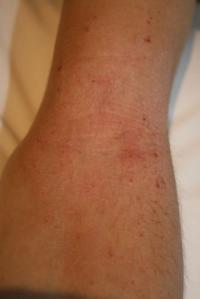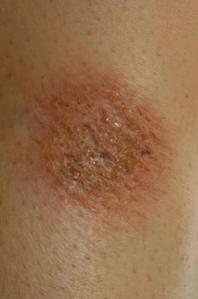Eczema is a broad term given to represent inflammation of the epidermis, or upper layer of the skin, being categorized further into several different subtypes such as nummular or discoid eczema, seborrheic dermatitis, stasis eczema, pompholox or dishydrotic eczema, contact dermatitis, and allergic or atopic dermatitis. The main symptoms that they all share are basically redness and itching! In terms of the standard Western treatment, pretty much every patient will be prescribed a topical cortico-steroid cream, regardless of the kind of eczema that it is. The western approach is basically a one size fits all, and as such will have varying degrees of success. Chinese medicine, on the other hand, will differentiate these types of eczema even further into sub-subtypes based on whether they are dry or wet. This deeper analysis will then dictate the type of treatment offered, so that a better short and long term result is achieved. The ‘one size fits all’ is contrary to the ‘individualized’ way of Chinese medicine, a system in which every person is diagnosed and treated as unique individuals- which is exactly the way it should be!
So if you have eczema, what is your type? The pictures below show two sides of the eczema spectrum. Basically a dry type and a wet / damp type.
Dry Type
The dry type of eczema is generally much itchier, there may be evidence of bloodier scabs or excoriated marks from scratching, and the borders of the lesion will be more diffuse and less defined. It is harder to see the difference between healthy and diseased skin. Dry types of eczema also tend to affect more the upper part of the body. The biggest trademark of the dry type of course is the dryness, as the skin will be much drier with more silvery scale and with little to no moist or damp discharge. Herbs used for these drier types have a dispersing and diaphoretic nature to help the excess heat escape from the surface of the body.
Damp Type
On the other side of the spectrum is the wet or damp types of eczema. These tend be to moist with exudate or wet discharge. The discharge will often times form a yellowish brown crust. The borders are also more clearly defined, so that healthy and diseased skin is easier to distinguish. These lesions are more often located in the lower parts of the body or in areas that are damp themselves like the groin, ears, and arm pits. People with damp types of eczema also tend to be more damp in general and will, more often than the dry types, suffer with night sweating. For the damp type, herbs will be used that activate urination to help the body rid the excess moisture.
Rarely are the two types so easily defined, as many people may have a mixture of the two. Some may suffer with very dry itchy lesions on their neck and face, but then behind their knees the lesions are wet with discharge. This is where Chinese medicine can become even more refined in its ability to compose a mixture of herbs that, again, fits the individual rather than the masses.
A Doctor of Chinese Medicine trained in Dermatology will know these simple principles and, when properly applied, can greatly help alleviate ones eczema effectively and for the long term.
Dr. Trevor Erikson


